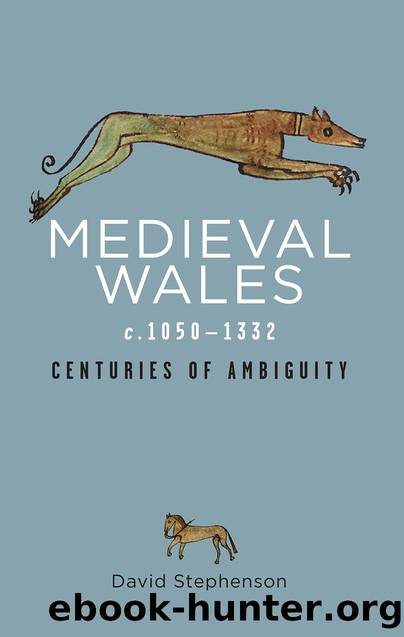Medieval Wales c.1050-1332: Centuries of Ambiguity by David Stephenson

Author:David Stephenson
Language: eng
Format: epub
ISBN: 9781786833884
Publisher: University of Wales Press
Published: 2013-06-15T00:00:00+00:00
5
New ascendancies
By the close of 1283 Edward Iâs armies and their allies in Wales and the March had secured the death of Llywelyn ap Gruffudd, the capture and execution of his brother Dafydd, and the capture, death or surrender of the lords who had supported them. The accoutrements of princely rule and dignity had been seized: the portion of the True Cross, alleged to have been handed down from prince to prince, was taken to the king by some of Dafyddâs men, while the seals of Llywelyn, his wife Eleanor and his brother Dafydd, were melted down and made into a chalice, given by Edward to Vale Royal abbey; Llywelynâs coronet was presented to the shrine of St Edward at Westminster.1
THE ESTABLISHMENT OF ROYAL DOMINANCE IN WALES
The king emphasized his triumph in 1284 by the holding of a Round Table at Nefyn in the LlÅ·n peninsula.2 Llywelyn had been eulogized as an Arthur, and by holding that most Arthurian of festivities Edward made it clear that he, and not the dead prince, was the true heir of Arthur; that point was made explicit when âthe crown of the famous King Arthur, for long held in great honour amongst the Welshâ was discovered and brought to Edward.3 The reality of conquest was made evident by the continuation of the programme of castle-building begun by Edward after the war of 1277, which extended the stone manifestations of royal power into western Gwynedd.4 And in the Statute of Wales of 1284, the new administrative structures of northwest Wales were established.5 There could be no doubt that a conquest had been effected. New laws were made, new boroughs were created and beyond the Edwardian Crown lands newly conquered territories were parcelled up and given out to the kingâs noble lieutenants, in the form of marcher lordships.
From the 1280s onwards, the March represented the greater part of Wales, extending in a great arc from east of the Conwy to the Dee, excluding only the three discrete territories of Tegeingl, Hopedale and Maelor Saesneg which constituted the new county of Flintshire, dependent on Chester.6 From the middle waters of the Dee the March then ran southward through much of eastern Wales. It included not only the bulk of the territories of the former northern Powys, but also the great barony of (southern) Powys, whose lords were determined to assume the status of Welsh barons of the March, and whose territory, extending as far west as the tidal reaches of the Dyfi, effectively severed the northern from the southern and western Crown lands.7 Much of the Middle March was Mortimer territory, while to the south lay the de Bohun land of Brycheiniog which bordered the various lordships of Gwent and the great Clare lordship of Glamorgan, where the March turned westwards, running along the whole of the southern coastal region and its hinterland, as far as the south-western extremity of Dyfed. These marcher territories were not fixed after 1284; some, such as the lordship of Builth, were now part of the March and now in the possession of the Crown.
Download
This site does not store any files on its server. We only index and link to content provided by other sites. Please contact the content providers to delete copyright contents if any and email us, we'll remove relevant links or contents immediately.
| Africa | Americas |
| Arctic & Antarctica | Asia |
| Australia & Oceania | Europe |
| Middle East | Russia |
| United States | World |
| Ancient Civilizations | Military |
| Historical Study & Educational Resources |
Room 212 by Kate Stewart(4739)
The Crown by Robert Lacey(4573)
Endurance: Shackleton's Incredible Voyage by Alfred Lansing(4507)
The Iron Duke by The Iron Duke(4122)
The Rape of Nanking by Iris Chang(4023)
Killing England by Bill O'Reilly(3898)
Joan of Arc by Mary Gordon(3784)
Say Nothing by Patrick Radden Keefe(3725)
I'll Give You the Sun by Jandy Nelson(3273)
Shadow of Night by Deborah Harkness(3176)
Hitler's Monsters by Eric Kurlander(3164)
Mary, Queen of Scots, and the Murder of Lord Darnley by Alison Weir(3066)
Blood and Sand by Alex Von Tunzelmann(3058)
Darkest Hour by Anthony McCarten(3018)
Margaret Thatcher: The Autobiography by Thatcher Margaret(2971)
Eleanor & Park by Rainbow Rowell(2943)
Red Famine: Stalin's War on Ukraine by Anne Applebaum(2816)
Book of Life by Deborah Harkness(2720)
The One Memory of Flora Banks by Emily Barr(2685)
